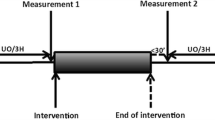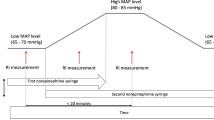Abstract
Purpose
Impact of volume challenge (VC) on renal hemodynamics and renal function in patients with septic-induced acute kidney injury in addition to transpulmonary thermodilution (TPTD)-derived hemodynamic parameters.
Methods
Systemic hemodynamic parameters derived from TPTD, Doppler-based resistive index (RI) urine output, creatinine and urea levels were obtained before, after and 24 h after VC.
Results
Heart rate (p < 0.045), systolic blood pressure (p < 0.030) and mean arterial pressure (p < 0.001) were significantly altered after VC in VC responders compared to baseline immediately after VC but not after 24 h (p = 0.719; p = 0.576; p = 0.435).TPTD-derived cardiac function parameter cardiac index significantly increased after VC (p < 0.001) as well after 24 h (p < 0.02) in the responder group. Stroke volume index also significantly increased after VC (0.033) in responders immediately after VC, but not after 24 h of VC (p < 0.073). No significant changes could be observed in the non-responder group.Renal RI was not significantly different between VC responders and VC non-responders (p = 0.55) immediately after VC and after 24 h (p = 0.65).Creatinine levels in VC responders significantly decreased after 24 h (p < 0.001). Urine output increased from 400 to 542 ml/d in responders, but not statistically significant (p = 0.09). Vasopressor dose in VC responders was statistically significantly lower after 24 h (p < 0.001) compared to baseline.
Conclusions
Responders to VC with septic-induced AKI can benefit from an optimized hemodynamic environment. The resistive index to guide fluid therapy for renal hemodynamic management may be limited by the small magnitude of the changes.
Similar content being viewed by others
References
Joannidis M, Druml W, Forni LG, Groeneveld ABJ, Honore P, Oudemans-van Straaten HM et al (2010) Prevention of acute kidney injury and protection of renal function in the intensive care unit. Expert opinion of the Working Group for Nephrology, ESICM. Intensive Care Med 36:392–411
Metnitz PG, Krenn CG, Steltzer H, Lang T, Ploder J, Lenz K, Le Gall JR, Druml W (2002) Effect of acute renal failure requiring renal replacement therapy on outcome in critically ill patients. Crit Care Med 30:2051–2058
Uchino S, Kellum JA, Bellomo R, Doig GS et al (2005) Acute renal failure in critically ill patients: a multinational, multicenter study. JAMA 294:813–818
Lameire N, Van Biesen W, Vanholder R (2005) Acute renal failure. Lancet 365:417–430
Schrier RW, Wang W (2004) Acute renal failure and sepsis. N Engl J Med 351:159–169
Dellinger RP, Levy MM, Rhodes A, Annane D, Gerlach H, Opal SM et al (2013) Surviving Sepsis Campaign: international guidelines for management of severe sepsis and septic shock 2012. Intensive Care Med 39:165–228
Payen D, de Pont AC, Sakr Y, Spies C, Reinhart K, Vincent J-L (2008) A positive fluid balance is associated with a worse outcome in patients with acute renal failure. Crit Care 12:R74
Moussa MD, Scolletta S, Fagnoul D, Pasquier P, Brasseur A, Taccone FS, Vincent JL, De Backer D (2015) Effects of fluid administration on renal perfusion in critically ill patients. Crit Care 12(19):250
Prowle JR, Bellomo R (2013) Fluid administration and the kidney. Curr Opin Crit Care. 19(4):308–314
Felbinger TW, Reuter DA, Eltzschig HK et al (2005) Cardiac index measurements during rapid preload changes: a comparison of pulmonary artery thermodilution with arterial pulse contour analysis. J Clin Anesth 17(4):241–248
Lerolle N, Guerot E, Faisy C, Bornstain C, Diehl JL, Fagon JY (2006) Renal failure in septic shock: predictive value of Doppler-based renal arterial resistive index. Intensive Care Med 32:1553–1559
Duranteau J, Deruddre S, Vigue B et al (2008) Doppler monitoring of renal hemodynamics: why the best is yet to come. Intensive Care Med 34:1360–1361
Deruddre S, Cheisson G, Mazoit JX et al (2007) Renal arterial resistance in septic shock: effects of increasing mean arterial pressure with norepinephrine on the renal resistive index assessed with Doppler ultrasonography. Intensive Care Med 33:1557–1562
Darmon M, Schortgen F, Vargas F et al (2011) Diagnostic accuracy of Doppler renal resistive index for reversibility of acute kidney injury in critically ill patients. Intensive Care Med 37:68–76
Huber W, Umgelter A, Reindl W et al (2008) Volume assessment in patients with necrotizing pancreatitis: a comparison of intrathoracic blood volume index, central venous pressure, and hematocrit, and their correlation to cardiac index and extravascular lung water index. Crit Care Med 36(8):2348–2354
Goepfert MS, Reuter DA, Akyol D et al (2007) Goal-directed fluid management reduces vasopressor and catecholamine use in cardiac surgery patients. Intensive Care Med 33(1):96–103
Fincke R, Hochman JS, Lowe AM et al (2004) Cardiac power is the strongest hemodynamic correlate of mortality in cardiogenic shock: a report from the SHOCK trial registry. J Am Coll Cardiol 44(2):340–348
Godje O, Hoke K, Goetz AE et al (2002) Reliability of a new algorithm for continuous cardiac output determination by pulse-contour analysis during hemodynamic instability. Crit Care Med 30(1):52–58
Michard F, Alaya S, Zarka V et al (2003) Global end-diastolic volume as an indicator of cardiac preload in patients with septic shock. Chest 124(5):1900–1908
Reuter DA, Felbinger TW, Schmidt C et al (2002) Stroke volume variations for assessment of cardiac responsiveness to volume loading in mechanically ventilated patients after cardiac surgery. Intensive Care Med 28(4):392–398
Katzenelson R, Perel A, Berkenstadt H et al (2004) Accuracy of transpulmonary thermodilution versus gravimetric measurement of extravascular lung water. Crit Care Med 32(7):1550–1554
Yoon DY, Kim SH, Kim HD, Na DG et al (1995) Doppler sonography in experimentally induced acute renal failure in rabbits. Resistive index versus serum creatinine levels. Invest Radiol 30:168–172
Platt JF, Rubin JM, Ellis JH (1991) Acute renal failure: possible role of duplex Doppler US in distinction between acute prerenal failure and acute tubular necrosis. Radiology 179:419–423
Bude RO, Rubin JM (1999) Relationship between the resistive index and vascular compliance and resistance. Radiology 211:411–417
LeDoux D, Astiz ME, Carpati CM, Rackow EC (2000) Effects of perfusion pressure on tissue perfusion in septic shock. Crit Care Med 28:2729–2732
Kirkpatrick AW, Colistro R, Laupland KB et al (2007) Renal arterial resistive index response to intraabdominal hypertension in a porcine model. Crit Care Med 35:207–213
Schnell D, Reynaud M, Venot M, Le Maho AL, Dinic M, Baulieu M et al (2014) Resistive index or color-Doppler semi-quantitative evaluation of renal perfusion by inexperienced physicians: results of a pilot study. Minerva Anestesiol 80:1273–1281
Dewitte A, Coquin J, Meyssignac B, Joannès-Boyau O, Fleureau C, Roze H et al (2012) Doppler resistive index to reflect regulation of renal vascular tone during sepsis and acute kidney injury. Crit Care 16:R165
Asfar P, Meziani F, Hamel J-F, Grelon F, Megarbane B, Anguel N (2014) High versus low blood-pressure target in patients with septic shock. N Engl J Med 370:1583–1593
Bagshaw SM, Bennett M, Devarajan P, Bellomo R (2012) Urine biochemistry in septic and non-septic acute kidney injury: a prospective observational study. J Crit Care 28:371–378
Darmon M, Schortgen F, Vargas F et al (2011) Diagnostic accuracy of Doppler renal resistive index for reversibility of acute kidney injury in critically ill patients. Intensive Care Med 37(1):68–76
Schnell D, Camous L, Guyomarch S et al (2013) Renal perfusion assessment by renal Doppler during fluid challenge in sepsis. Crit Care Med 41(5):1214–1220
Authors’ contribution
Tobias Lahmer (TL), Sebastian Rasch (SR), Christopher Schnappauf (CS), Roland M Schmid (RMS), Wolfgang Huber (WH) have contributed to this study. TL, CS, SR, RMS, WH studied the design. TL, CS, SR, WH collected data. TL, CS, SR, RMS, WH were involved in data analysis. TL, CS, SR, RMS, WH wrote the manuscript. Study is approved by the institutional review board of the Technical University of Munich, Germany. Written informed consent was obtained.
Author information
Authors and Affiliations
Corresponding author
Ethics declarations
Conflict of interest
Wolfgang Huber collaborates with Pulsion Medical Systems SE (Feldkirchen, Germany) as member of the Medical Advisory Board. All other authors have no conflict of interest to disclose.
Rights and permissions
About this article
Cite this article
Lahmer, T., Rasch, S., Schnappauf, C. et al. Influence of volume administration on Doppler-based renal resistive index, renal hemodynamics and renal function in medical intensive care unit patients with septic-induced acute kidney injury: a pilot study . Int Urol Nephrol 48, 1327–1334 (2016). https://doi.org/10.1007/s11255-016-1312-1
Received:
Accepted:
Published:
Issue Date:
DOI: https://doi.org/10.1007/s11255-016-1312-1




